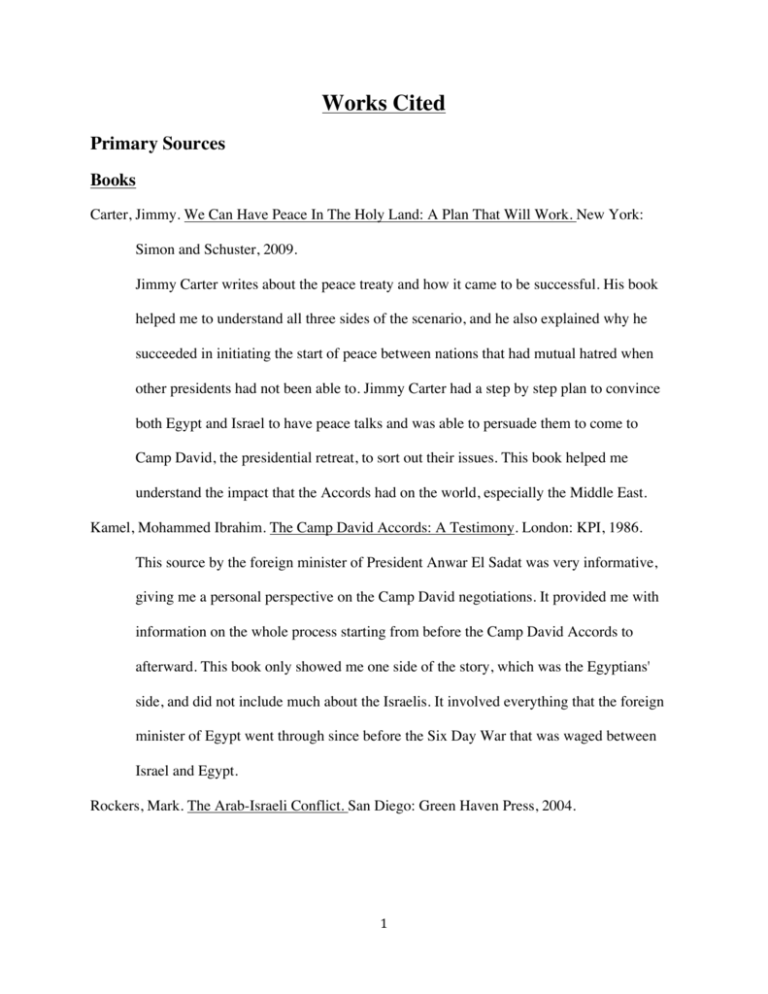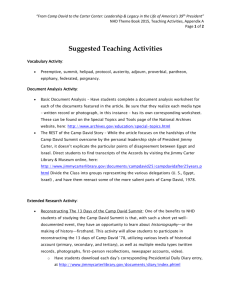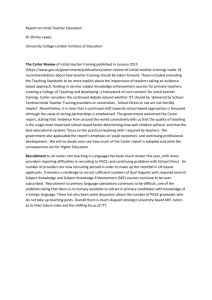Bibliography - National History Day
advertisement

Works Cited Primary Sources Books Carter, Jimmy. We Can Have Peace In The Holy Land: A Plan That Will Work. New York: Simon and Schuster, 2009. Jimmy Carter writes about the peace treaty and how it came to be successful. His book helped me to understand all three sides of the scenario, and he also explained why he succeeded in initiating the start of peace between nations that had mutual hatred when other presidents had not been able to. Jimmy Carter had a step by step plan to convince both Egypt and Israel to have peace talks and was able to persuade them to come to Camp David, the presidential retreat, to sort out their issues. This book helped me understand the impact that the Accords had on the world, especially the Middle East. Kamel, Mohammed Ibrahim. The Camp David Accords: A Testimony. London: KPI, 1986. This source by the foreign minister of President Anwar El Sadat was very informative, giving me a personal perspective on the Camp David negotiations. It provided me with information on the whole process starting from before the Camp David Accords to afterward. This book only showed me one side of the story, which was the Egyptians' side, and did not include much about the Israelis. It involved everything that the foreign minister of Egypt went through since before the Six Day War that was waged between Israel and Egypt. Rockers, Mark. The Arab-Israeli Conflict. San Diego: Green Haven Press, 2004. 1 This book consisted of various speeches by those involved with the Camp David Accords from Anwar Sadat to Jimmy Carter. Carter spoke about the prerequisites for peace, and Sadat spoke about Egypt coming to Israel with a peace treaty. Interviews Miller, Aaron David. Skype Interview. 22 January 2013. Mr. Aaron David Miller is a renowned author of The Much Too Promised Land: America’s Elusive Search for Arab-Israeli Peace. He did extensive research on the Camp David Accords. Mr. Miller served at the Department of State as an advisor to the Republican and Democratic Secretaries of State for the past two decades. There, he helped formulate U.S Policy on the Middle East. In this interview, Mr. Miller gave me his perspective on how the negotiations affected the Middle East today. Mondale, Walter. Email Interview. 15 Feb. 2013. Mr. Walter Mondale was the former Vice President under Jimmy Carter. In this interview, he was able to tell me about his experience at Camp David and how he knew that the Accords were a very risky process, but he was very optimistic about them. Finally, Mr. Mondale described how he thought that the Camp David Accords were a turning point in U.S Foreign Policy and how it affects foreign policy today. This was a very exciting interview! Quandt, William. Skype Interview. 17 Feb. 2013. Mr. William Quandt is the Edward R. Stettinius chair at the University of Virginia. He played a crucial role in the Camp David negotiations as one of the press members there. He described his experience of being outside the doors when President Carter was talking to both Prime Minister Begin and President Sadat. In addition, he was able to tell me his 2 thoughts on how the Camp David Accords were both a success and a failure due to the resolution of the ongoing conflict between Egypt and Israel but the inability to resolve the Palestinian issue. Newspaper Articles “A Sense of Betrayal.” Time. 9 October 1978: 51. This article was written from the perspective of the people who were living in Israel at the time when Prime Minister Menachem Begin went to Camp David to meet with President Carter and President Sadat. The people all shared their opinion on making peace with the Arabs. Most stated that there would never be peace with the Arabs because it was more than just a border or territorial issue, it was a religious problem. “Carter’s Swift Revival.” Time. 2 October 1978: 8,9. This source explained mostly about Carter and how his success with the Camp David Accords was his revival. Carter had previously been regarded as a weak president who was not well liked. After the Camp David Accords, when Carter traveled to different states, people applauded him for his achievement in implementing peace in the Middle East. This article included a great amount of information about Carter’s political career. “Camp David Letters Still Not Ready.” Times London. 21 September 1978. This article, published after the Camp David Accords signing, describes how the letters regarding disagreements at the Accords have still not been completed. The letters, Patrick Brogan writes, state that the future of Jerusalem should have no problem because Prime Minister Begin and President Sadat agreed to disagree. 3 “Camp David Summit Agrees On New Framework For Peace.” Times London. 17 September 1978. This source summarizes the compromise that the Camp David summit was able to bring about in the short two weeks. This article also included another article on how Israel withdrew from the Sinai Peninsula. “Clearing the Way for Peace.” Time. 9 October 1978: 50, 52. A very interesting article that provided me with important information about what Begin and Sadat had to go through in order to have peace with each other. Though they had positive supporters including the Knesset, the Israeli government, there were a lot of antipeace rioters who did not wish to have peace with a nation that they had always been at war with. In addition, the PLO was amidst all of this and they wanted liberation for the Palestinians and for the Palestinians to have their own state. “Critical Point Reached At Camp David.” Times London. 12 September 1978. This article is on the critical point that would turn the whole of the Camp David Summit around. The main obstacle in the Camp David Accords, the author states, is what the future of West Bank would be. Conclusions were drawn from Sadat’s talking to King Hussein that the Americans would force Israel to withdraw from the West Bank. “Divided Arabs React With Fury and Contempt.” Times London. 18 September 1978. Describing the different reactions of the Arabs after the signing of the Accords, this article gave me a good insight into the various reactions that were demonstrated after Sadat and Begin returned to their home countries. 4 “How to end up No. 2.” Time. 12 March 1979: 16. After the Camp David Accords signing, there were new realities about American power and resources and the nation’s ability to manage events throughout the world. In this article, it shows how Carter was ready to adjust to these new realities. However, this article also had a negative connotation toward Carter. It showed how President Carter lowered his expectations, thus making it harder for him to “sustain influence around the globe.” Gwertzman, Bernard. “A Year After Camp David: Egypt and Israel Still Seek Peace Despite Setbacks.” New York Times.15 September 1979: 3. This article brings out that the Camp David Accords were a major success, but that there were still many gaps. This caused a wide ranging problem for not only President Carter’s reputation as a president, but also President Sadat of Egypt’s and Prime Minister Begin’s of Israel. For example, the Palestinian issue was a huge impediment, but both Begin and Sadat agreed to put a hold on the matter of the Palestinians. They would deal with that matter after they had firstly come to good terms. “No Spirit of Camp David: But Carter and Begin meet for one last try to save the peace talks.” Time. 12 March 1979: 13. From this descriptive article, I was able to gather what Begin and Sadat really wanted. Begin didn’t want to concede any of his settlements that had been built on the Sinai Peninsula, but Sadat would not agree to peace until Begin ceded his territories. This article described how both Begin and Sadat met at Camp David, but even there, there were lots of misunderstandings. 5 Quandt, William. “10 years after Camp David. Now What?” New York Times. 17 September 1988: 27. Quandt wrote this article reviewing how the Camp David Accords were a success, but were also a failure. He laid out the points showing that the Camp David Accords had a negative impact such as being unable to prevent the Lebanese War of 1982. “Sadat Still Supports 1978 Accords over Other Proposals, Israelis Say.” New York Times. 9 Feb 1981: A4. In this article, there is a description of how Sadat still has faith in the Camp David Accords. Even though he was trying to normalize relations with other countries in the Middle East at the same time as he was with Israel, he believed that he still agreed to everything in the Camp David Agreements. After the Camp David Accords, both Sadat and Begin began to support normalizing the relations between Israel and Egypt. Smith, Hendrick. “After Camp David Summit, A Valley of Hard Bargaining.” New York Times. 6 November 1978: 49. Smith’s editorial discusses how there was supposed to be the “bright vision of peace” after the Camp David Accords, but the negative reactions of the people in the Arab world negated that effect. When Sadat and Begin arrived at their home countries after signing the Camp David Agreements, they saw mostly positive reactions, but there were those who rioted against the peace. Overall, Smith depicted the different reactions of not only powerful leaders in the world, but also the common people. Tanner, Henry. “Egypt Denies Any Violations of Peace Accords with Israel.” New York Times. 14 April 1982: A10. 6 Tanner’s article portrays how Israel believes that Egypt is ruining the spirit of the Camp David agreements and how Egypt denies this allegation. In addition, this article also described how the Arab world is improving its pattern of peace after the Camp David Agreements, thus clearly laying out the impact that the agreements had on the world. Manuscripts Camp David Accords. MFA. Israel Ministry of Foreign Affairs. <http://www.mfa.gov.il/MFA/Peace%20Process/Guide%20to%20the%20peace% 20process/Camp%20David%20Accords%>. This was the transcript of the Camp David Accords and what everyone agreed to. The transcript gave me a perspective of what was most important to both Prime Minister Menachem Begin of Israel and President Anwar Sadat of Egypt. This helped me understand what foreign policy negotiations were like. Carter, Jimmy. Letter to President Sadat. 3 August 1978. Jimmy Carter Library. 2 Feb 2013. <http://www.jimmycarterlibrary.gov/documents/campdavid25/cda08.pdf>. Carter’s handwritten letter to President Sadat, convincing him to meet Carter at Camp David. Carter, Jimmy.. Letter to President Sadat and Prime Minister Begin. 15 September 1978. Jimmy Carter Library. 1 Feb 2013. <http://www.jimmycarterlibrary.gov/documents/campdavid25/cda11.pdf>. This was a congratulatory message from Carter to Sadat and Begin on the signing of the Accords. 7 Carter, Jimmy. Letter to Prime Minister Menachem Begin. 3 August, 1978. Jimmy Carter Library. 30 Jan 2013. <http://www.jimmycarterlibrary.gov/documents/campdavid25/cda09.pdf>. The transcript of Carter’s letter to Prime Minister Begin, inviting Begin to come to Camp David to attempt peace with President Anwar Sadat. Kissinger, Henry. Letter to Jimmy Carter. 18 September 1978. Jimmy Carter Library. 2 Feb 2013. <http://www.jimmycarterlibrary.gov/documents/campdavid25/cda15.pdf>. This was a letter from Henry Kissinger, the Secretary of State, congratulating Carter on the signing of the Accords United States Senate. Letter to Jimmy Carter. 28 June 1977. <http://www.jimmycarterlibrary.gov/documents/campdavid25/cda03.pdf>. The actual transcript of the Senate’s letter to President Carter on how they were willing to help Carter in regards to the Middle East in any way. Secondary Sources “Camp David.” World Book Advanced. World Book, 2012. Web. 3 Nov. 2012. This source gave me information on Camp David itself, which was where the Accords were signed. “Camp David Accord.” PBS. 5 Nov. 2012. <http://www.pbs.org/wgbh/americanexperience/features/general-article/carter-legacy/> Although brief, this source provided me with essential information about the Camp David Accords as well as the impact it had on both the United States and the Middle East. “The Camp David Accords.” Jimmy Carter Library. 16 December 2003. 24 December 2012. <www. jimmycarterlibrary.gov/documents/campdavid/>. 8 This website had a compilation of three subsections, including all the transcripts of Carter’s letters to Sadat and Begin. This source also included the transcripts of the Camp David Accords themselves. Finally, it included a photograph gallery with pictures from the actual event. This was a “golden source” and very valuable. Churchill, Randolph. The Six Day War. Boston: Houghton Mifflin Company, 1967. Written by the grandson of Winston Churchill, this book is on the Six Day War which sparked the Camp David Accords. This book describes the Six Day War in great detail, describing the positions of both Egypt and Israel, and why the Six Day War led up to the Yom Kippur War. Glad, Betty. “Carter’s Greatest Legacy: The Camp David Negotiations.” PBS. 06 Nov. 2012 <http://www.pbs.org/wgbh/americanexperience/features/general-article/carter-legacy/>. A fascinating website with key facts about the Camp David Accords. It included everything from events that led up to the Accords to the legacy of it. Glad’s website also discussed how Carter was successful in leading the negotiations and why he was the only president able to succeed in bringing peace to the Middle East. It showed me the key points that Carter highlighted before approaching both Prime Minister Menachem Begin and President Sadat and inviting them to Camp David. Morris, Benny. 1948: The First Arab-Israeli War. New Haven: Yale University Press, 2008. Morris' book described the 1948 Arab-Israeli War which declared Israel as an independent state. This led to hostility between Arab countries and Israel, leading up to the October War of 1967 and then the Yom Kippur War of 1973. Quandt, William B. Camp David: Peacemaking and Politics. Washington D.C: The Brookings Institution, 1986. 9 Quandt’s book gave me a sense of the historical context that encircled the Camp David Accords and the policies that the United States enforced towards the Middle East. A bulky book, it investigated the causes and effects of the Accords. Rackers, Mark. The Arab-Israeli Conflict. Farmington HIlls: Greenhaven Press, 2004. This source is on the full Arab-Israeli conflict, beginning with the independence of Israel. I was able to understand the context surrounding the tension in the Middle East as well as the peace process that Carter was able to take. Vogele, William B. “Arab-Israeli Conflict.” World Book Advanced. World Book, 2012. Web. 3 Nov. 2012. Vogele’s article broadened my knowledge about the events that occurred before the Camp David Accords. It was a very substantial source, providing me with intricate details about the wars and events leading up to the treaty. “World Reaction: Camp David Accords could Lead to World War III.” 9 April 1979. 5 Jan. 2013. <http://www.larouchepub.com/eiw/public/1979/eirv06n13-1979043/eirv06n131979043-026-world-reaction-camp-david-could.pdf7.> From this website, I was able to gain the reactions of people all around the world. From those reactions, I was able to understand that some people even believed that a World War III could occur. Interviews Moore, Peter. Personal Interview. 2 Feb. 2013. Dr. Moore is a history professor at Case Western Reserve University. His interests include economic development specifically in the Gulf Arab States. He was able to provide me with a good historical context on the Camp David Accords and what the 10 ongoing conflict in Palestine was about. In addition, his perspective on the shift in foreign policy after Carter stepped into the presidency was very helpful. Oakman, Jonathon. Skype Interview. 25 Feb. 2013. Jonathon Oakman has written a case study on the Camp David Accords which deeply analyzes the Accords. Mr. Oakman is a very distinguished author and businessman who has always been interested in public policy. Today, Mr. Oakman works in economic development after graduating from Princeton University in 2002. Photographs http://2.bp.blogspot.com/-gN_ImcYWrOk/TdLkiN71byI/AAAAAAAAAXg/wKipJy4z8k/s1600/camp-david-map-2007.jpg A satellite view of the presidential retreat, Camp David http://www4.pictures.gi.zimbio.com/Thirty+Years+Since+Signing+Egypt+Israel+Peace+Ha5xcr gnjfNl.jpg Begin and Sadat’s handshake http://arcweb.archives.gov/arc/digital_detail.jsp?&pg=1&st=b&tn=174030 Portrait of Zbigniew Brzezinski http://www.biography.com/imported/images/Biography/Images/Profiles/C/Jimmy-Carter9240013-1-402.jpg Portrait of Former President Jimmy Carter http://cdnmedia.nationaljournal.com/?controllerName=image&action=get&id=17669&format=m Gallery Osama El-Baz in a meeting with Sadat http://content.answcdn.com/main/content/img/getty/0/5/3309405.jpg 11 President Sadat, President Carter, and Premier Begin at Camp David http://www.corbisimages.com/images/Corbis-IH154222.jpg?size=67&uid=24bfaa22-487f-413fa1b9-c6f887842640 Sadat, Carter, and Begin on listening to the Pledge of Allegiance http://www.dodmedia.osd.mil/Assets/1982/Air_Force/DF-SC-82-05418.JPEG ID:DFSC8205418 Anwar Sadat portrait http://electronicintifada.net/sites/electronicintifada.net/files/artman2/1/barak-483.jpg Portrait of legal advisor and Supreme Court justice of Israel, Aharon Barak http://fanack.com/typo3temp/pics/israel_campdavid_sign_hh_03647968_02_7277cab455.jpg Carter, Begin, and Sadat signing the Accords http://future.state.gov/future/who/secretary/former/vance_c.html Cyrus Vance, Secretary of State of the United States http://images.alarabiya.net/79/9b/640x392_32690_209622.jpg Egyptian and Israeli flags http://www.instablogs.com/wp-content/uploads/2012/07/menachem_begin_2j3568_Re1Zd_19672.jpg Prime Minister Begin portrait http://jewishworldnews.org/wp-content/uploads/2011/09/il01_08a1.jpg Sadat upon his immediate arrival in Israel http://www.kingsacademy.com/mhodges/03_The-World-since-1900/12_The-Uncertain70s/pictures/T75-115_Sadat-Begin+Carter_1979.jpg Begin and Sadat hugging after the signing of the Accords http://lancasteronline.com/blogs/flashbacklancaster/wp-content/uploads/2008/10/debate-6.jpg 12 Former Presidents Carter and Nixon debating http://media-3.web.britannica.com/eb-media/72/126172-004-CFC3BFDD.jpg The three leaders meeting in Carter’s office to discuss the Accords http://media.npr.org/programs/morning/features/2003/sept/carter/campd_1406ee186588d657b50b301648837f9b2f03c2a8922-s6-c10.jpg The three leaders signing the Accords http://www.mfa.gov.eg/FormerMinister/%D9%85%D8%AD%D9%85%D8%AF%D8%A5%D8 %A8%D8%B1%D8%A7%D9%87%D9%8A%D9%85%20%D9%83%D8%A7%D9%85 %D9%84.JPG Portrait of Foreign Minister Mohammed Ibrahim Kamel http://www.nowtheendbegins.com/blog/wpcontent/uploads/us_20_21_pic_carter_sadat_begin.jp g The three way handshake between President Carter, Prime Minister Begin, and President Sadat. http://prints.encore-editions.com/500/0/egyptian-president-anwar-sadat-and-israeli-primeminister-menachem-begin-acknowledge-applause-during-a-joint-session-of-congress-inwhich-president-jimmy-carter-announced-the-results-of-the-camp-david-accords.jpg Sadat and Begin meet during the Sadat Initiative http://www.thetimes.co.uk/tto/multimedia/archive/00309/2805432_Begin_Sadat_309811b.jpg Begin upon greeting Sadat in Israel http://www.veteransnewsnow.com/wp-content/uploads/2012/07/Camp-David-Accords-2.jpg The three leaders after the signing of the Accords. http://www.ydfa.com/artists/david_harris/images/9026.jpg 13 Begin and Sadat at dinner http://zionism-israel.com/bio/Ezer_Weizman.jpg Ezer Weizman, the Minister of Defense for Israel 14







